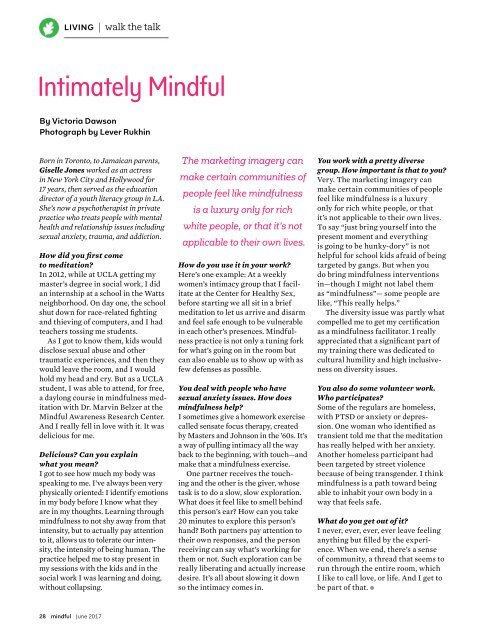Mindful June 2017
You also want an ePaper? Increase the reach of your titles
YUMPU automatically turns print PDFs into web optimized ePapers that Google loves.
LIVING | walk the talk<br />
Intimately <strong>Mindful</strong><br />
By Victoria Dawson<br />
Photograph by Lever Rukhin<br />
Born in Toronto, to Jamaican parents,<br />
Giselle Jones worked as an actress<br />
in New York City and Hollywood for<br />
17 years, then served as the education<br />
director of a youth literacy group in LA.<br />
She’s now a psychotherapist in private<br />
practice who treats people with mental<br />
health and relationship issues including<br />
sexual anxiety, trauma, and addiction.<br />
How did you first come<br />
to meditation?<br />
In 2012, while at UCLA getting my<br />
master’s degree in social work, I did<br />
an internship at a school in the Watts<br />
neighborhood. On day one, the school<br />
shut down for race-related fighting<br />
and thieving of computers, and I had<br />
teachers tossing me students.<br />
As I got to know them, kids would<br />
disclose sexual abuse and other<br />
traumatic experiences, and then they<br />
would leave the room, and I would<br />
hold my head and cry. But as a UCLA<br />
student, I was able to attend, for free,<br />
a daylong course in mindfulness meditation<br />
with Dr. Marvin Belzer at the<br />
<strong>Mindful</strong> Awareness Research Center.<br />
And I really fell in love with it. It was<br />
delicious for me.<br />
Delicious? Can you explain<br />
what you mean?<br />
I got to see how much my body was<br />
speaking to me. I’ve always been very<br />
physically oriented: I identify emotions<br />
in my body before I know what they<br />
are in my thoughts. Learning through<br />
mindfulness to not shy away from that<br />
intensity, but to actually pay attention<br />
to it, allows us to tolerate our intensity,<br />
the intensity of being human. The<br />
practice helped me to stay present in<br />
my sessions with the kids and in the<br />
social work I was learning and doing,<br />
without collapsing.<br />
The marketing imagery can<br />
make certain communities of<br />
people feel like mindfulness<br />
is a luxury only for rich<br />
white people, or that it’s not<br />
applicable to their own lives.<br />
How do you use it in your work?<br />
Here’s one example: At a weekly<br />
women’s intimacy group that I facilitate<br />
at the Center for Healthy Sex,<br />
before starting we all sit in a brief<br />
meditation to let us arrive and disarm<br />
and feel safe enough to be vulnerable<br />
in each other’s presences. <strong>Mindful</strong>ness<br />
practice is not only a tuning fork<br />
for what’s going on in the room but<br />
can also enable us to show up with as<br />
few defenses as possible.<br />
You deal with people who have<br />
sexual anxiety issues. How does<br />
mindfulness help?<br />
I sometimes give a homework exercise<br />
called sensate focus therapy, created<br />
by Masters and Johnson in the ’60s. It’s<br />
a way of pulling intimacy all the way<br />
back to the beginning, with touch—and<br />
make that a mindfulness exercise.<br />
One partner receives the touching<br />
and the other is the giver, whose<br />
task is to do a slow, slow exploration.<br />
What does it feel like to smell behind<br />
this person’s ear? How can you take<br />
20 minutes to explore this person’s<br />
hand? Both partners pay attention to<br />
their own responses, and the person<br />
receiving can say what’s working for<br />
them or not. Such exploration can be<br />
really liberating and actually increase<br />
desire. It’s all about slowing it down<br />
so the intimacy comes in.<br />
You work with a pretty diverse<br />
group. How important is that to you?<br />
Very. The marketing imagery can<br />
make certain communities of people<br />
feel like mindfulness is a luxury<br />
only for rich white people, or that<br />
it’s not applicable to their own lives.<br />
To say “just bring yourself into the<br />
present moment and everything<br />
is going to be hunky-dory” is not<br />
helpful for school kids afraid of being<br />
targeted by gangs. But when you<br />
do bring mindfulness interventions<br />
in—though I might not label them<br />
as “mindfulness”— some people are<br />
like, “This really helps.”<br />
The diversity issue was partly what<br />
compelled me to get my certification<br />
as a mindfulness facilitator. I really<br />
appreciated that a significant part of<br />
my training there was dedicated to<br />
cultural humility and high inclusiveness<br />
on diversity issues.<br />
You also do some volunteer work.<br />
Who participates?<br />
Some of the regulars are homeless,<br />
with PTSD or anxiety or depression.<br />
One woman who identified as<br />
transient told me that the meditation<br />
has really helped with her anxiety.<br />
Another homeless participant had<br />
been targeted by street violence<br />
because of being transgender. I think<br />
mindfulness is a path toward being<br />
able to inhabit your own body in a<br />
way that feels safe.<br />
What do you get out of it?<br />
I never, ever, ever, ever leave feeling<br />
anything but filled by the experience.<br />
When we end, there’s a sense<br />
of community, a thread that seems to<br />
run through the entire room, which<br />
I like to call love, or life. And I get to<br />
be part of that. ●<br />
28 mindful <strong>June</strong> <strong>2017</strong>


